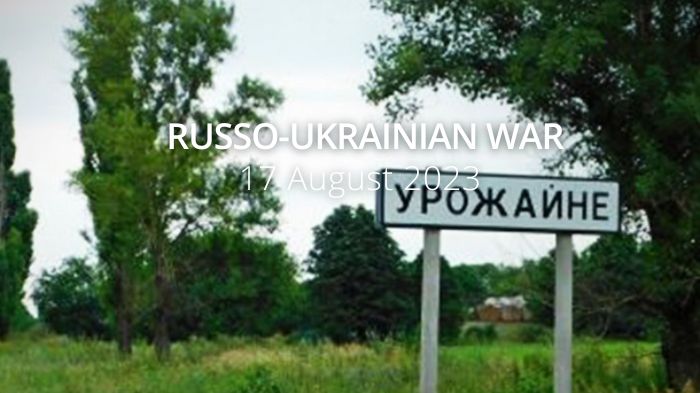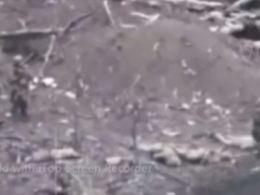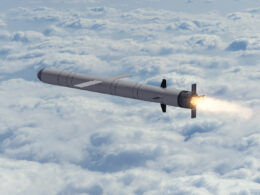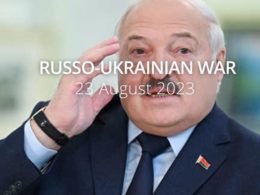Ukraine liberates Urozhaine in Donetsk Oblast. Russia destroys grain hangars in Odesa region. NATO official who mentioned Ukrainian membership in exchange for territory apologises.
Daily review – August 17, 2023
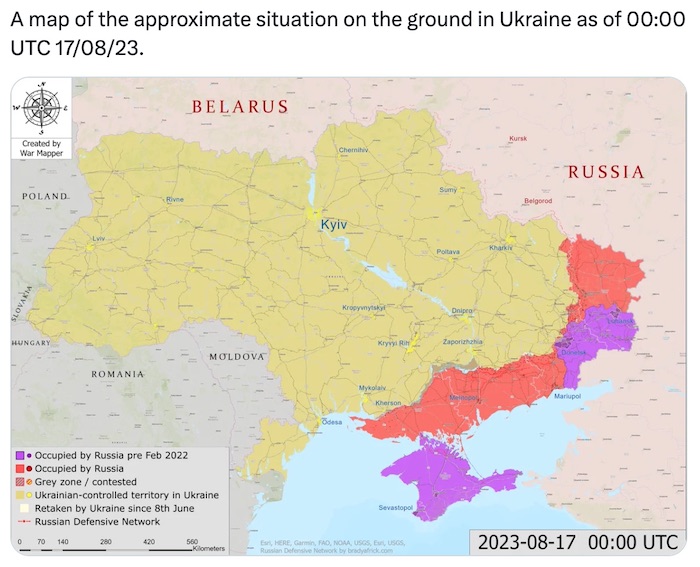
According to information from the General Staff as of 06.00 17.08.2023, supplemented by its [18:00 assessment].

“On August 16, the enemy launched 8 missiles and 82 airstrikes, 76 MLRS attacks at the positions of Ukrainian troops and various settlements. Unfortunately, the Russian terrorist attacks have killed and wounded civilians, including children. The port infrastructure in Odesa oblast, residential buildings and other civilian infrastructure in Kharkiv, Luhansk, Donetsk, Dnipropetrovsk, and Kherson oblasts have been destroyed.
According to the updated information, air defence forces and means intercepted 2 Kh-35/Kh-59 cruise missiles and 16 Shahed-136/131 UAVs of the enemy On August 16.
The likelihood of missiles and airstrikes across Ukraine remains high.
On August 16, there were 20 combat engagements.
- Volyn and Polissya axes: no significant changes.
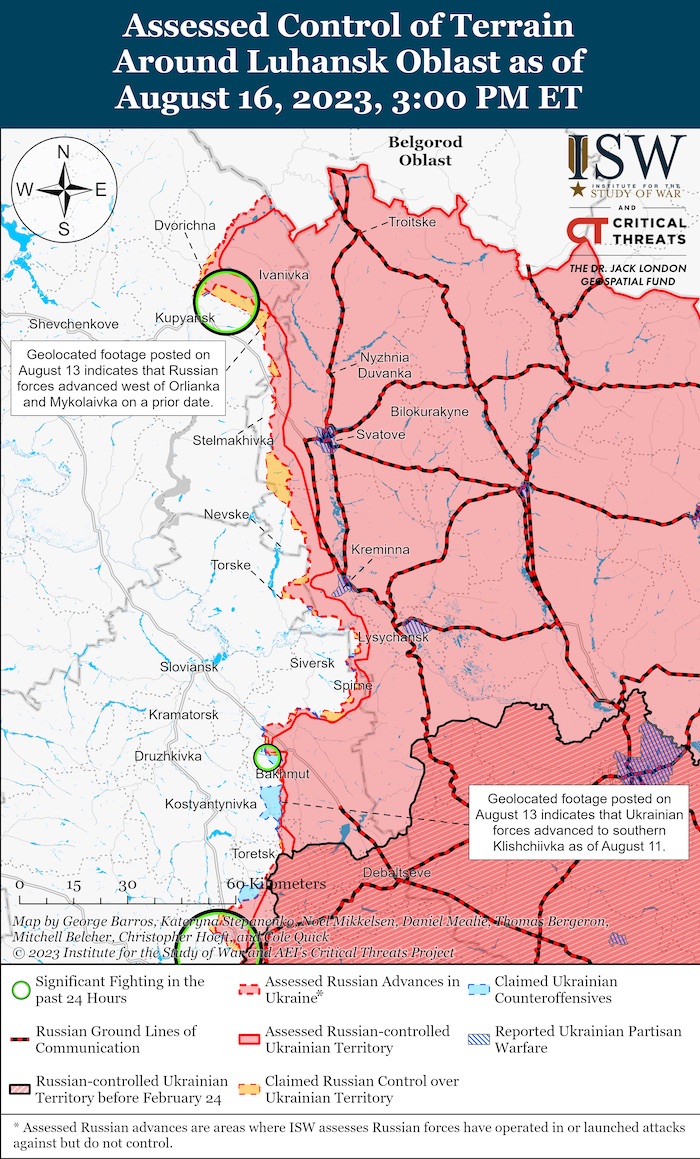
- Sivershchyna and Slobozhanshchyna axes: the adversary launched airstrikes in the vicinities of Chervona Zorya, Veterynarne, Kozacha Lopan’, Hatyshche, and Rohan’ (Kharkiv oblast). The invaders fired mortars and artillery at more than 15 settlements, including Tymonovychi, Bleshnya (Chernihiv oblast), Tur’ya, Stepok, Hrabovs’ke (Sumy oblast), Vovchans’k, Vovchans’ki Khutory, Okhrimivka, Potykhonove, and Chuhunivka (Kharkiv oblast).
- Kupiansk axis: the adversary launched airstrikes in the vicinities of Kup’yans’k, Petropavlivka, Podoly, Tabaivka, Pisky-Rad’kivs’ki, Cherneshchyna (Kharkiv oblast), and Nadiya (Luhansk oblast). The invaders conducted unsuccessful offensive operations in the vicinity of Sen’kivka (Kharkiv oblast). The settlements of Vil’shana, Petropavlivka, and Cherneshchyna (Kharkiv oblast) came under artillery and mortar fire from the adversary.
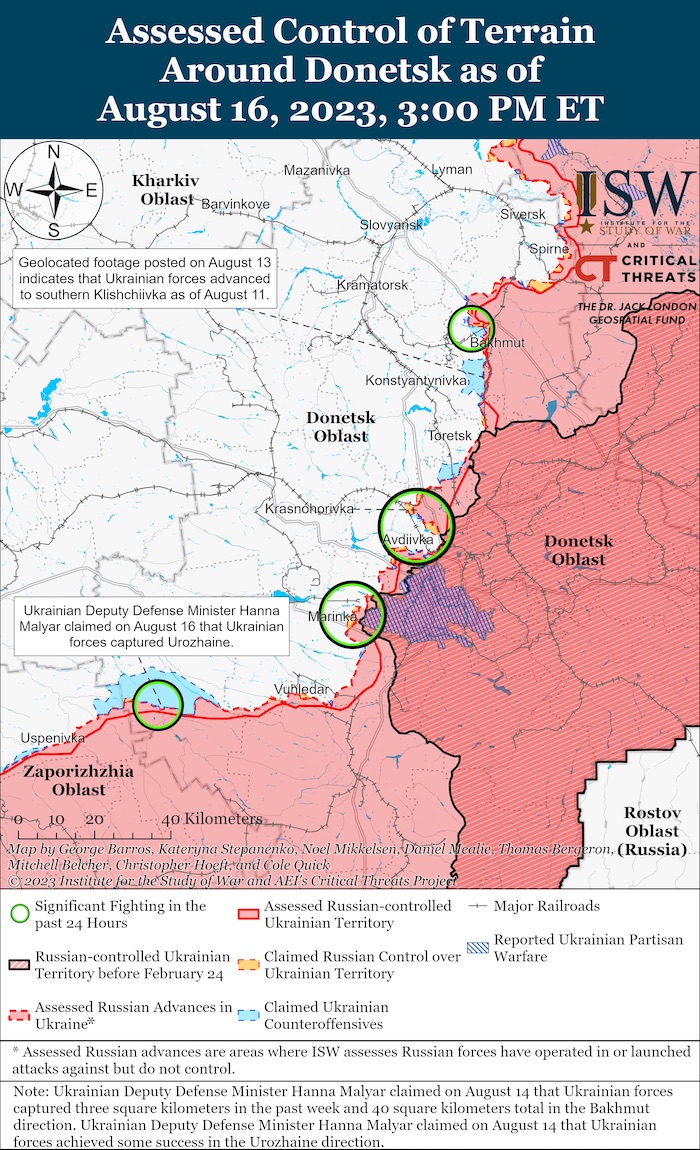
- Lyman axis: the adversary launched airstrikes in the vicinities of Makiivka, Nevs’ke, Bilohorivka (Luhansk oblast), and Sivers’k (Donetsk oblast). About 20 settlements, including Nevs’ke, Dibrova, Bilohorivka (Luhansk oblast), Vyimka, Pereizne, Rozdolivka, and Pazeno (Donetsk oblast), were shelled with artillery.
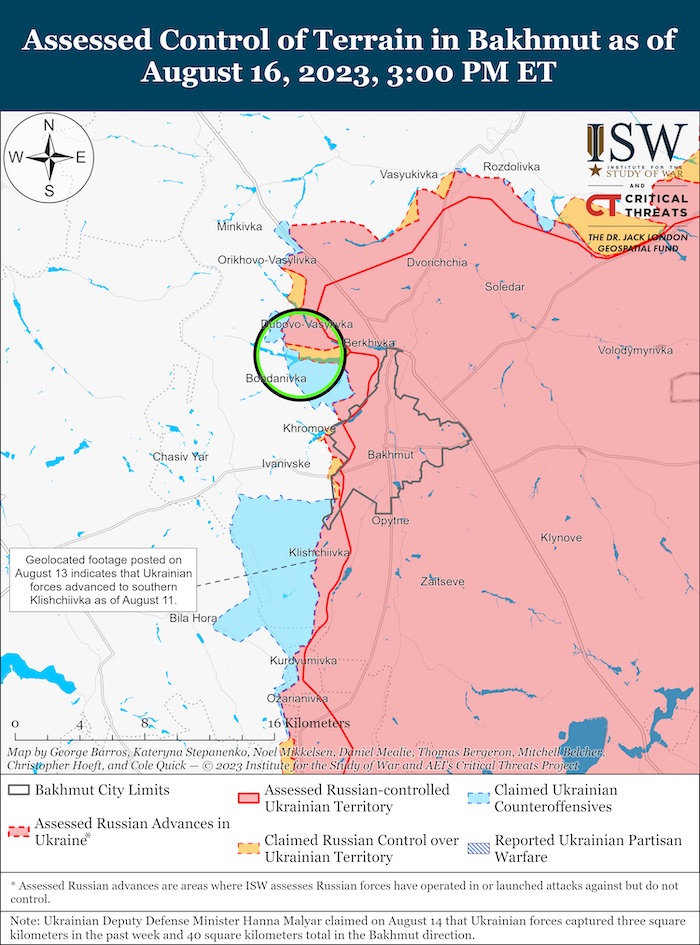
- Bakhmut axis: the adversary conducted unsuccessful offensives in the vicinity of Bohdanivka (Donetsk oblast). The invaders launched airstrikes in the vicinities of Ivanivka, Pryvillya, Min’kivka, and Bila Hora (Donetsk oblast). More than 15 settlements, including Andriivka, Bila Hora, Dyliivka, and Pivnichne (Donetsk oblast), suffered from enemy artillery shelling.
- Avdiivka axis: under heavy fire from enemy aircraft and artillery, the Ukrainian defenders continue to hold back Russian troops’ advance in the vicinity of Avdiivka (Donetsk oblast). The invaders fired artillery at more than 10 settlements, including Oleksandropil’, Novokalynove, Avdiivka, Tonen’ke, Sjeverne, Pervomais’ke, and Nevel’s’ke (Donetsk oblast).
- Marinka axis: the Ukrainian Defence Forces continue to hold back the Russian offensive in the vicinity of the city of Mar’inka (Donetsk oblast). The enemy launched airstrikes in the vicinities of Krasnohorivka and Novomykhailivka (Donetsk oblast). The invaders fired artillery at more than 10 settlements, including Krasnohorivka, Mar’inka, Pobjeda, Paraskoviivka, and Vodyane (Donetsk oblast).
- Shakhtarske axis: the enemy launched airstrikes in the vicinities of Blahodatne, Urozhaine, and Staromaiors’ke (Donetsk oblast). More than 10x settlements, including Vodyane, Bohoyavlenka, Vuhledar, Prechystivka, Velyka Novosilka, Blahodatne, and Urozhaine (Donetsk oblast), came under artillery shelling.
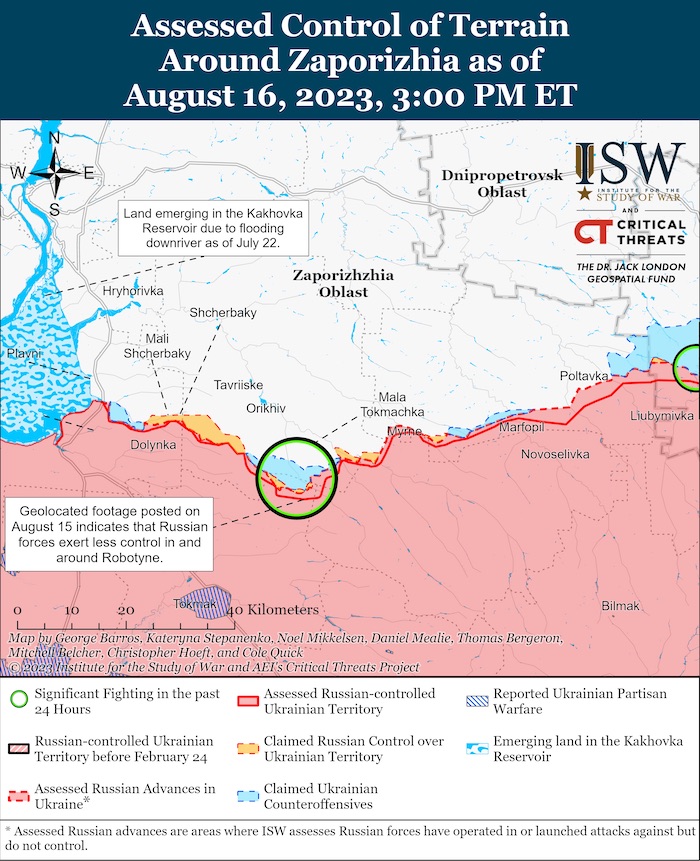
- Zaporizhzhia axis: the adversary launched airstrikes in the vicinities of Mala Tokmachka and Novodanylivka (Zaporizhzhia oblast). More than 20 settlements suffered from enemy artillery shelling, including Omel’nyk, Novoandriivka, Kam’yans’ke, Plavni, and Luk’yanivs’ke (Zaporizhzhia oblast).
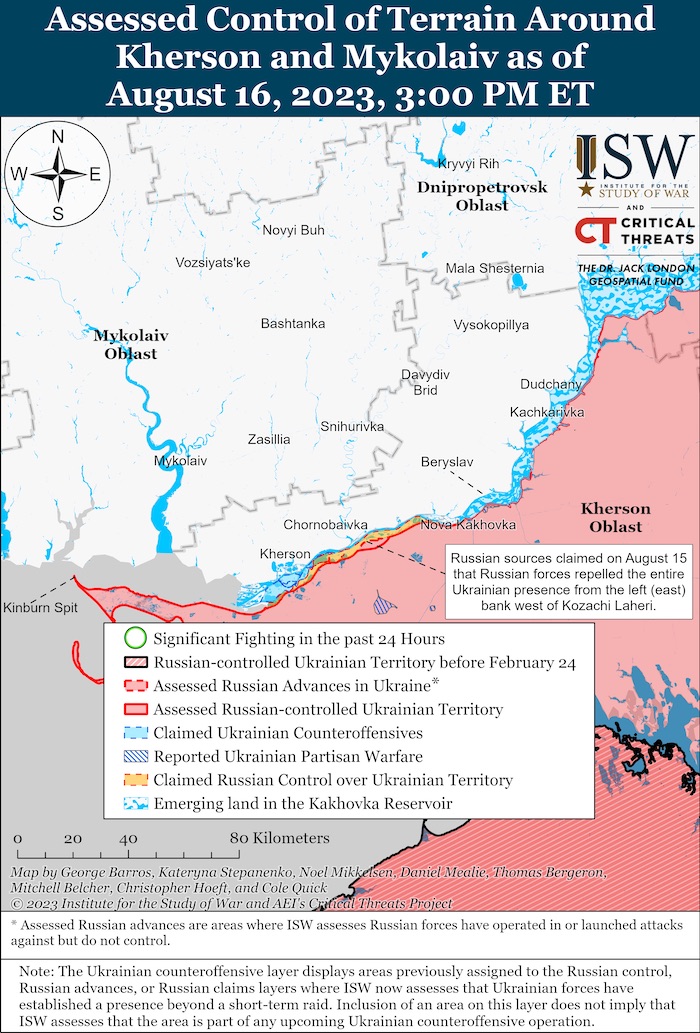
- Kherson axis: the enemy fired artillery at more than 10 settlements, including Khreshchenivka, Novodmytrivka, Mykolaivka, Sadove, Zelenivka, Berehove, Kizomys (Kherson oblast), and the city of Kherson.
The Russian invaders continue to use the civilian infrastructure of the temporarily occupied settlements to provide medical care to their wounded servicemen. In the settlement of Shevchenkivs’ke (Zaporizhzhia oblast), Russian servicemen have re-purposed the territory of a civilian building into a field hospital, where more than 30 wounded occupants are being treated.
At the same time, the Ukrainian Defense Forces continue to conduct the offensive operation on Melitopol’ and Berdyans’k axes, consolidating their positions, and conducting counter-battery fire.
On August 16, Ukrainian Air Force launched 10 airstrikes on the concentrations of troops, weapons, and military equipment, as well as 1 airstrike on the anti-aircraft missile systems of the adversary. Also, the Ukrainian defenders intercepted 8 operational-tactical level reconnaissance UAVs of the enemy.
On August 16, Ukrainian missile and artillery troops hit 1 anti-aircraft missile system of the adversary.“
Military Updates

Invaders lose 265 soldiers, 15 equipment units in Tavria direction, Ukrinform reports. “Artillery units of the Defense Forces performed 1,393 fire missions during the day. Over the past day, the enemy lost 265 people killed, wounded and captured (killed – 95, wounded – 159, captured – 11), Oleksandr Tarnavskyi, the commander of the operational and strategic group of troops "Tavria", reported.
He added that 15 units of enemy military equipment had been destroyed, in particular, three tanks, four artillery systems and mortars, one ATGM, one anti-tank grenade launcher, and six vehicles.”
Ukrainian defenders liberate Urozhaine, Ukrainska Pravda reports. “Hanna Maliar, Deputy Defence Minister of Ukraine, has reported that Ukrainian defenders have liberated the village of Urozhaine in Donetsk Oblast. […] Andrii Kovalov, Spokesman for the General Staff of Ukraine’s Armed Forces, said Ukraine’s Defence Forces were continuing to conduct offensive operations on the Bakhmut, Melitopol and Berdiansk fronts.
Kovalov said that Ukrainian soldiers are using artillery to fire on detected Russian targets and are carrying out counter-battery operations. The Ukrainian Defence Ministry has been reporting the successes near Urozhaine for several days in a row.”
Ground Forces Commander visits defenders of Kupiansk: Situation escalates, important decisions made, Ukrainska Pravda reports, citing Military Media Centre. “General Colonel Oleksandr Syrskyi, the Commander of the Ground Forces of Ukraine's Armed Forces, has arrived at a camp of the units of the defence forces of Ukraine deployed on the Kupiansk front in Kharkiv Oblast. He came there in connection with the escalation of the combat situation. […] Syrskyi reported that following the discussion with the commanders on this front, important decisions that will strengthen the defence were taken.
On the Lyman front, the Russians are regrouping, replacing the units that lost their combat ability as a result of the losses they suffered, and do not give away any plans to conduct new offensive actions. "Our task is to use this situation to our own advantage and improve our position. We worked on the necessary decisions with the commanders directly in the combat zone," Syrskyi stressed.
On the Bakhmut front, the situation is complicated but under control. The Russians are conducting counter attacks, mining the territory, intensely launching attacks and deploying aircraft. Nevertheless, even in such harsh conditions, the defence forces of Ukraine are gradually advancing.
We have discussed with the commanders of the brigades that fight on the Bakhmut front the burning issues of increasing the efficiency of offensive actions, damage and a number of other measures aimed at defeating the Russians, Syrskyi added.”
Russians attack Kharkiv, air defence systems responding, Ukrainska Pravda reports, citing the Ukrainian Air Force. “The Russian forces are bombarding Kharkiv Oblast; Ukrainian air defence forces are responding. An air-raid warning was issued in Kharkiv Oblast. The Ukrainian Air Force reported that high-speed targets are moving towards Kharkiv. Local residents are urged to stay in shelters. Furthermore, the air-raid warning was also issued in Donetsk and Poltava oblasts as of 15:55. There is a missile threat in Poltava Oblast.
Oleh Syniehubov, Head of Kharkiv Oblast Military Administration, said the Russian forces were bombarding Kharkiv Oblast. The Ukrainian air defence forces were responding to the attack.”
On the night of August 16, 2023, the Russian occupying forces attacked the port infrastructure of Odesa with Shahed-136/131 attack UAVs, the Ukrainian General Staff reports. “The launches of "shakheds" were carried out in several waves from the south-eastern direction (Primorsko-Akhtarsk, Chauda). The forces and means of the Air Force in cooperation with the anti-aircraft defense of the Defense Forces of Ukraine destroyed 13 enemy UAVs within the Odesa and Mykolaiv regions.”
According to British Defence Intelligence, (last 48 hours):
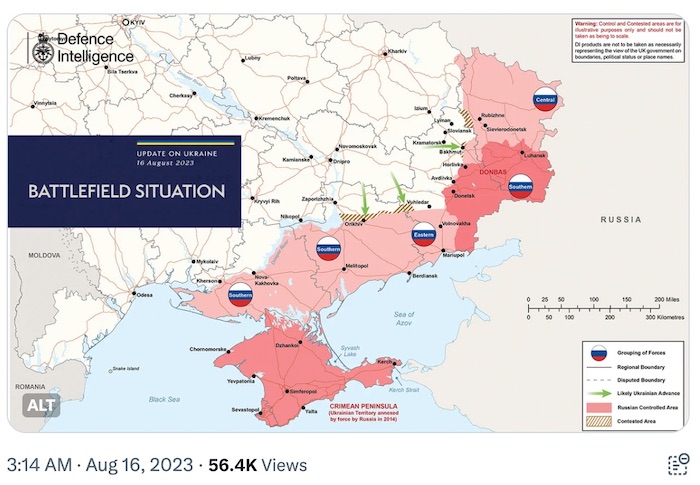
- Despite the consistent pressures of war, Ukrainian efforts to build up fuel stockpiles will likely be successful in ensuring that it will have sufficient fuel reserves during the approaching winter period.
- Ukraine has been effective in mobilising its mining sector to maintain output, ensuring a continuous supply of coal is available for thermal power and heating plants in the winter, with substantial gas stocks providing a further reserve.
- Despite Russian attacks on Ukraine’s energy infrastructure likely continuing this winter, Ukraine demonstrated last winter that it has the skilled workforce and expertise needed to operate and maintain the power network, even in wartime conditions.
- Russia has almost certainly started to deploy domestically produced one way attack Uncrewed Aerial Vehicles (OWA-UAVs) based on Iranian Shahed designs. Russian forces have been importing Iranian-made systems since September 2022.
- Indigenous manufacturing will likely allow Russia to establish a more reliable supply of OWA-UAVs. The performance of these weapons has been variable and Ukraine has proved effective in neutralising the majority of incoming OWA-UAVs.
- Russia likely aims for self-sufficiency in OWA-UAVs in the coming months. However, in the interim, Russia remains reliant on components and whole weapons from Iran, primarily shipped via the Caspian Sea.
Losses of the Russian Army
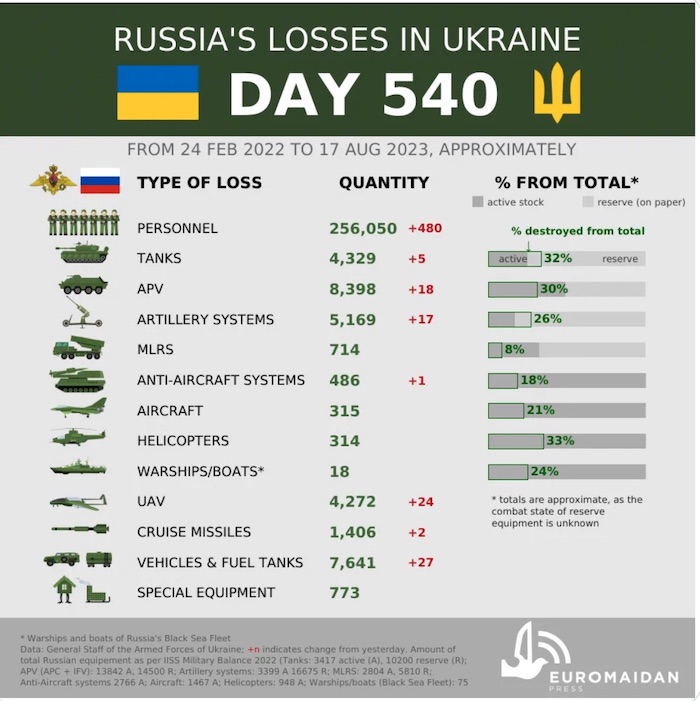
As of Thursday 17 August, the approximate losses of weapons and military equipment of the Russian Armed Forces from the beginning of the invasion to the present day:
- Personnel – about 256050 (+480)
- Tanks – 4329 (+5)
- Armoured combat vehicles – 8398 (+18)
- Artillery systems – 5169 (+17))
- Multiple rocket launchers –MLRS - 714 (+0)
- Air defence means – 486 (+1)
- Aircraft - 315 (+0)
- Helicopters - 314 (+0)
- Automotive technology and fuel tanks – 7641 (+27)
- Vessels/boats - 18 (+0)
- UAV operational and tactical level – 4272 (+24)
- Special equipment – 773 (+0)
- Mobile SRBM system – 4 (+0)
- Cruise missiles – 1406 (+2)
Logistical problems of Russians in Crimea growing, Ukrinform reports, citing Natalia Humeniuk, the head of the Joint Press Center of the Operational Command South. “Logistical problems of Russians in the temporarily occupied Crimea are increasing. The fact is that the peninsula is indeed turning into an island in a logical sense because logistics are complicated and slowed down. But there are still ways in which it can be realized. But it is overloaded on those routes because the same directions are used for military needs as for civilian ones. That is, supplies to the peninsula itself for civilians are also carried out via the same routes that are more or less functional. We are talking about the mainland. They are trying to repair the bridges. Both the big one they were so proud of and the smaller ones they need so badly, said Humeniuk.
According to her, the enemy is trying to set up repair teams, but it is very difficult to do so. It is difficult to find personnel, so they have to be driven away at gunpoint because people realize that it is very dangerous. And if it has been hit, it is within the range of the Defense Forces' weapons. This means that pontoon crossings, as an alternative, are not safe there either, added the head of the Joint Press Center of the Operational Command South.”
Humanitarian
Russian raid off Türkiye's coast tests Erdogan's resolve, Reuters reports. “Russia's raid on a ship just off Türkiye's coast brings the fallout from the Ukraine war to another NATO frontier and raises the stakes as Ankara seeks to coax Moscow back to a grain-export deal that would restore some calm to the Black Sea. Armed marines raided the Turkish-based vessel via helicopter on Sunday some 60 km (37 miles) off Türkiye's northwest coast, in international waters but near Istanbul, in what Moscow called an inspection before it sailed on to Ukraine.
Türkiye, NATO's second-largest military, has made no public comment on the incident that occurred far south of the war that has raged for a year-and-a-half in the north Black Sea. Analysts said it tests President Tayyip Erdogan's resolve to maintain good relations with Russian President Vladimir Putin, whom he has invited to Türkiye this month to discuss resuming the UN-brokered deal that had protected grain exports from Ukraine.
This type of aggression being exercised so close to Istanbul went unchecked and doesn't respect Türkiye's overall rights, said Yoruk Isik, an Istanbul-based geopolitical analyst at the Bosphorus Observer consultancy. Ankara's silence is strange but shows it is still counting on Putin to visit and return to the grain deal.
Since Russia exited the agreement last month, both it and Ukraine have issued warnings and carried out attacks on vessels off their coasts, stirring worries that commercial-shipping could grow riskier across the entire sea. While Ukraine and some other Western states have promoted alternative routes for Ukrainian exports, Ankara, which also has good relations with Kyiv, quietly opposes them on safety grounds. It wants the West to accept some Russian demands, and for Russia to drop others, to restart Ukraine grain exports under UN and Turkish oversight.
On Wednesday, Russia struck more Ukrainian port facilities even as Kyiv announced that a container ship departed Odesa under its own "humanitarian corridor", one of the alternative options. […] Since the year-long grain deal collapsed, boosting global commodity prices and raising UN concerns over world hunger, Russia and Ukraine have said they will treat ships approaching the other's ports as potential military vessels. Aydin Sezer, a former Turkish diplomat and Ankara-based foreign policy analyst, said Russia's inspection of the Palau-flagged Sukru Okan vessel technically took place in a war zone, given Moscow and Kyiv's warnings over ships.
Given Türkiye has sent armed drones and other weapons to Ukraine while also claiming to be neutral in the war, it is very challenging for Türkiye to find its voice on this matter, he said. Türkiye has positioned itself to facilitate any peace talks between Ukraine and Russia. It has opposed the Russian invasion but also the Western sanctions on Moscow and ramped up economic cooperation with Russia through the war. […]
Russia has said it would return to the grain deal once the West fulfils obligations meant to ensure the smooth export of its own grain and fertilisers, including payments and logistics. Sezer said its two key demands are including a Russian bank in the global SWIFT payments system and allowing it to import agriculture-related goods. Therefore, Erdogan should negotiate and try to convince Western countries, not Putin, for the reinstatement of the grain deal, he said.”
First civilian vessel passed through Ukrainian humanitarian corridor in Black Sea, Censor.net reports, citing President Zelenskyy. “On the evening of August 16, the President of Ukraine, Volodymyr Zelenskyy, announced that the first civilian ship had passed through the new Ukrainian humanitarian corridor, leaving the Odesa port and heading for the Bosphorus. He noted: Ukraine has just taken an important step towards restoring freedom of navigation in the Black Sea. The first civilian vessel passed through the new Ukrainian humanitarian corridor, leaving the Odesa port. Now it is heading to the Bosphorus.
Earlier, Ukraine officially informed the International Maritime Organization about the operation of the corridor. The IMO reaffirmed Ukraine's sovereign rights to regulate navigation and called on Russia to stop threats and adhere to international conventions. The sea should be safe for everyone. This is fundamental for Ukraine and our partners. Freedom and security of navigation are fundamental principles of international relations.”
In Odesa region, enemy destroyed hangars with grain, Censor.net reports, citing the Odesa City Council. “At night, the enemy attacked the southern regions of Ukraine with several waves of attack drones. At first, the enemy attacked Mykolaiv region, where the air defence forces did an excellent job - all drones were destroyed. Later, they attacked the south of Odesa region in two powerful waves.
Air defence forces destroyed 13 Shahed-136 drones, the statement said.
It is noted that the enemy hit the territory of one of the ports, destroying hangars with grain and agricultural machinery. The fires were quickly extinguished by rescuers.”
Environmental
Nearly 2,500 cases of environmental damage caused by war recorded in Ukraine, Ukrinform reports. “For more than 500 days of the full-scale war, nearly 2,500 cases of damage to the environment caused by the war have been recorded. The total damage is estimated at 52 billion euros," First Deputy Prime Minister– Minister of Economy of Ukraine Yulia Svyrydenko posted on Facebook.
According to Svyrydenko, due to the Russian invasion, 174,000 sq km of Ukrainian land are potentially contaminated with explosive objects. Therefore, the urgent task is to unite the efforts of the whole world around the elimination of these problems, so that the experience of overcoming these problems becomes the basis of efforts to establish peace. The key goals of environmental security within the framework of the Peace Formula are damage assessment, accountability for Russia, and climate transformation of the Ukrainian economy.”
Information about Russian plans to carry out provocations at Kursk and Zaporizhzhia NPPs, Censor.net reports, citing Ukrinform, quoting the chief specialist of the Strategic Communications Department of the Office of the Commander-in-Chief of the Armed Forces of Ukraine, Colonel Taras Dziuba. “There is no confirmed data that the enemy is really going to resort to provocation at the Kursk and Zaporizhzhia nuclear power plants. […] The scenario with a provocation at the Zaporizhzhia NPP with the aim of disrupting the active actions of the Armed Forces of Ukraine and other Defense Forces of Ukraine, aimed at liberating the territory from the occupiers, was previously warned. However, as of today, there is no confirmation of the enemy's intentions to carry out such a provocation in the near future. […]
According to Dziuba, yesterday the Russian dictator Vladimir Putin held a working meeting with the general director of Rosatom, Oleksiy Likhachev. In the published transcript of which the issues of nuclear power plant safety were not discussed at all. […]
The mentioned publications in the unofficial Russian mass media, which were picked up by some of our sources, are measures of the informational and psychological operation of the Russian Federation, the purpose of which may be to create anxiety and panic among the population of Ukraine, and the broadcast of certain messages in foreign mass media may shape public opinion in various countries of the world in the interests of the enemy, Dziuba emphasized. He noted that this is especially important on the eve of the meeting of the leaders of the leading countries in the G-20 format, which will take place on September 9-10 in Delhi.”
Ukraine's Armed Forces use thermal imagers to find Russian mines, Ukrainska Pravda reports, citing CNN. “CNN reported that the Ukrainian Armed Forces are using experimental thermal imaging devices to uncover Russian mines. A CNN journalist saw Ukrainian soldiers on the front installing a thermal imaging camera on a commercial drone at dusk. The camera hovers over Russian minefields and detects dozens of thermal signatures [traces]. Some of them are craters, but many of them are mines barely hidden under the surface.
The heat that the mines receive from the bright summer sun during the day is retained as the sun goes down, making them more clearly visible on the thermal imaging camera. Soldiers from the 15th Separate National Guard Regiment stationed near the embattled village of Robotyne told CNN that the tactic is an effective means of detecting some mines. CNN footage shows the mines being detonated by Ukrainian charges, which detonate and at least partially eliminate the threat. This is yet another example of Ukrainian soldiers’ ingenuity supplementing the armour and weapons provided by NATO countries in recent months to help in the counteroffensive, CNN said. […]
CNN reported that Ukrainian soldiers often use drones with thermal imaging cameras, but the scale of the task is enormous: according to official Ukrainian estimates, Russian forces rigged more than 180,000 square kilometres with explosives, and there are often up to five explosive devices per square metre.
A drone team on a frontline position near the village of Robotyne told CNN the area around them was laden with mines. Oleksandr from the 15th National Guard Regiment said: When we entered one forest area, we found up to 53 booby traps. They’re not just made of one grenade – we call it a bouquet, grenades full of other grenades."
Legal
Ukrainian prisoners of war were beaten and tortured with electric shocks in Taganrog pre-trial detention center, - BBC, Censor.net reports, citing ВВС. “Ukrainian prisoners of war were subjected to brutal torture during their stay in detention center No. 2 in Taganrog. In an interview with the BBC, more than a dozen former prisoners of war, released as part of the exchange, reported the details of systematic physical and psychological violence during their stay in pre-trial detention center No. 2 in Taganrog.
According to the accounts of former prisoners, men, and women in Taganrog were repeatedly beaten, including beatings on the kidneys and chest, as well as electric shocks during daily checks and interrogations.
The Ukrainians said that the Russian guards constantly threaten and intimidate the prisoners, some of them gave false confessions, which were allegedly used as evidence against them in trials. According to those who returned from captivity, they were hardly fed there, and the wounded did not receive adequate medical care, as a result of which, it is claimed, some prisoners died in custody.”
Enemy is trying to imitate process of integration of occupied territories into Russian Federation, Censor.net reports, citing Ukrinform with reference to Andriy Yusov, the Defence Intelligence of Ukraine. “Russians are brought to the temporarily occupied territories to simulate the process of integration of these lands into the Russian Federation. It is not only about the elections. Wherever there is a need to simulate some process of state formation or integration of these territories into the Russian neo-empire, Russians are brought in: Russian teachers, Russian law enforcement officers, Russians even workers. And so, some other Russians will be brought to the "elections" for simulations and productions of the process.
These all outline very important things. This means that the Ukrainian local population perceives racists as invaders, and Russians and Russia as aggressors, and does not support any of these criminal actions and rejects them. This means that Ukrainians are waiting for their return and release. And it will definitely happen, Yusov emphasized.”
Support
Talked about plans of AFU, - Zaluzhnyi held extended meeting with American and British allies, Censor.net reports, citing General Zaluzhnyi on Telegram. “Yesterday, an important meeting with American and British partners took place in an expanded format. Together with the Chief of the General Staff General Shaptala, Deputy Commander-in-Chief General Zabrodsky, Navy Commander Admiral Neizhpapa, First Deputy Minister of Defence General Pavliuk, and Chief of the Defence Intelligence of Ukraine General Budanov, held constructive talks with Supreme Allied Commander Europe and US Allied Commander Europe General Cavoli, Chief of the UK Defence Staff Admiral Radakin and representatives of partner delegations.
Cooperation in the military sphere was a key topic of discussion. I spoke about the situation at the frontline, and the course of our offensive and defensive operations. I shared the plans of the Armed Forces for the near future and in the longer term. We discussed the possible actions of the enemy. We also focused on the needs of military units: ammunition, weapons, air defense equipment, electronic warfare, remote demining devices - these are the things that are needed.
Another extremely important issue is drones. Countering enemy drones and building up our own capabilities. We agreed with our partners to focus our work in this area. We also discussed the possibility of strengthening the protection of critical infrastructure from enemy air attacks."
Ukraine's Defence Intelligence confirms Russia is assembling Shahed attack UAVs: reason for Ukraine to step up air defence, Ukrainska Pravda reports, citing Andrii Yusov, spokesman for the Defence Intelligence of Ukraine (DIU). “The Russians have started the semi-knocked-down assembly of Iranian-made Shahed kamikaze drones on their territory. We are now talking about a semi-knocked-down assembly. Certain parts of Russian production come into play. It's something primitive, the simplest thing that the Russians are capable of producing in this weapon.
Yusov said Shahed UAVs are not highly sophisticated or advanced weapons. The Russians have intentions and plans to enter full-scale production. However, they have been setting this goal for a long time but have failed to achieve it so far. Meanwhile, Yusov believes this is a severe challenge for Ukraine and the Ukrainian Security and Defence Forces. This is also a reason for the country's partners to strengthen Ukrainian air and missile defence systems and assets.
On 13 August, analysts of the independent UK research group Conflict Armament Research reported that Russia had begun producing and using its own analogue of Iranian-made Shahed kamikaze drones to attack Ukraine, having examined drones shot down by the Ukrainian military. In June, US intelligence posted a satellite image proving the construction of a facility in the Russian Republic of Tatarstan [the federal subject of the Russian Federation in the country’s European part – ed.] to produce Iranian-made kamikaze drones.”
We will not be able to defend Ukraine with F-16s this fall and winter. Air defence needs to be strengthened, Censor.net reports, citing RBC-Ukraine with reference to the statement of the speaker of the Air Force of the Armed Forces of Ukraine Yurii Ihnat. “It is already obvious that we will not be able to protect Ukraine with F-16 aircraft this fall and winter, Ihnat stressed. According to him, there were high hopes for the aircraft, as it could become part of air defence and help defend against Russian missile terrorism.
However, as it was, the issue has moved from place to place. We understand that our pilots will be training in the near future. But at the same time, strengthening of our air defence needs to be carried out, added the spokesman of the Air Force.”
New developments
- Ukrainian President's Office reacts to NATO's idea of giving away Ukrainian territories, Ukrainska Pravda reports. “Mykhailo Podoliak, Advisor to the Head of the Office of the President of Ukraine, has sharply criticised a statement made by a NATO representative to the effect that the Alliance could grant membership to Ukraine in exchange for territorial concessions to Russia. Trading territory for a NATO umbrella? It is ridiculous. That means deliberately choosing the defeat of democracy, encouraging a global criminal, preserving the Russian regime, destroying international law, and passing the war on to other generations. Podoliak believes that unless Russian dictator Vladimir Putin suffers a crushing defeat, the war will certainly come back and Russia will have an appetite for more. Attempts to preserve the world order and establish a "bad peace" through, let's be honest, Putin's triumph will not bring peace to the world, but will bring both dishonour and war."
- NATO Official Who Mentioned Ukrainian Membership in Exchange for Territory Apologises, European Pravda reports. “Stian Jenssen, the head of the NATO Secretary General's Office, has referred to his proposals to discuss Ukraine's membership of the North Atlantic Alliance in exchange for territorial concessions to Russia as a "mistake." As reported by Norwegian VG, Jenssen noted that his statement was part of a broader discussion about possible future scenarios in Ukraine. I should not have spoken about it in this way. It was a mistake, added the NATO official. He pointed out that his statement from the previous day regarding membership in exchange for territory needs clarification after causing a media uproar. "If – and I emphasised, if – you get to the point where you can negotiate, the military situation on the battlefield, who controls what, will play a central role and will certainly have a decisive impact on what the possible outcome of this war will look like," Jenssen mentioned. Therefore, Jenssen pointed out that it is extremely important that we support Ukraine with what it needs. […] Jenssen specifically underscored that it is Ukraine that should decide under what conditions it will be ready to start negotiations with Moscow and what those negotiations will be about.”
- Ukraine's Deputy PM: Road to victory will be long, let's not think about life after it, Ukrainska Pravda reports. “Iryna Vereshchuk, the Deputy Prime Minister of Ukraine and Ukraine’s Minister for Reintegration of the Temporarily Occupied Territories, has stated that the war with Russia will continue for a long time and will not end either by the end of this year or next spring, as some hope. […] Let's not think about [life] after [the war]. We do our best here and now. Take it easy. Day by day. And we support each other. That's also important. That's why we survived last year. That's why we will win, in the end.”
- Moldova's President calls Russia primary source of instability, European Pravda reports, citing NewsMaker. “President Maia Sandu has named Russia as the primary source of instability for the country, while regarding Romania as a key ally. […] Russia will continue to be a source of instability for us. You have seen how Russian forces attempted to destabilise the situation in Moldova this year, even going so far as attempting to overthrow constitutional power. On the other hand, we are fortunate that Romania supports Moldova. It is an important defender that backs our foreign policy, she added. At the same time, Sandu noted that Moldova is currently facing a decisive moment that will shape the country's future.”
- Latvia sends army to guard border with Belarus as illegal crossing attempts mount, Reuters reports. “Latvia's defence minister ordered the army to help guard the Baltic country's border with Russian ally Belarus on Tuesday, after 96 attempts by illegal immigrants to cross in 24 hours. Border Guard officers have also been recalled from their holidays to help with patrols. Latvia has information about a possible increase in hybrid threats, the Border Guard said in a statement. Belarusian authorities were increasingly involved in organising the flow of illegal immigrants, it said. […] Poland has also seen an increase in the number of mainly Middle Eastern and African migrants trying to cross the border in recent months.”
- Poland and Baltic States discuss possibility of closing border with Belarus, Ukrainska Pravda reports, citing LRT (Lithuanian National Radio and Television), citing Agnė Bilotaitė, Lithuania’s Minister of the Interior. “Poland and the Baltic States (Latvia, Lithuania and Estonia) are discussing the measures and procedures that would need to be put in place if the circumstances required them to close their borders with Belarus. We agreed to coordinate technical measures and procedures around a possible regional solution agreed by the Baltic States and Poland. We are continuing to work on the technical and political details. A meeting of [the representatives of] the Baltic States and Poland is expected to take place in Warsaw on 28 August, where we will agree the final details of what a synchronous border closure would look like. […] As of 18 August, the Lithuanian government will temporarily close two out of six Belarus border crossings.”
- Security guarantees for Ukraine: Bulgaria joins G7 declaration, Ukrinform reports, citing BTA. “The Council of Ministers of Bulgaria on Wednesday adopted a decision approving Bulgaria's joining the G7 declaration on security guarantees for Ukraine. […] As reported by Ukrinform, the leaders of the Group of Seven (G7) countries agreed on the Joint Declaration of Support for Ukraine on the sidelines of the NATO Summit in Vilnius on July 11-12. Later, Belgium, the Czech Republic, Greece, Denmark, Finland, Iceland, Ireland, Latvia, the Netherlands, Norway, Portugal, Romania, Spain and Sweden joined the declaration. The list continues to grow.”
- Several Russian women supposedly poisoned abroad, Ukrainska Pravda reports, citing The Insider. “The Insider stated that over the past year, a new wave of poisonings has affected journalists and activists who have left Russia. In October 2022, Elena Kostyuchenko, a journalist for Novaya Gazeta and Meduza, was poisoned in Munich; a week later, Ekho Moskvy journalist Irina Babloyan suffered almost identical symptoms in Tbilisi; and in the spring, Natalia Arno, head of the Free Russia Foundation, was poisoned with a neurotoxic substance. The perpetrators have not yet been identified, but the Insider editors have consulted with the victims and decided to reveal the available data to warn activists and journalists who have left Russia about the existing threat.”
Assessment
- On the War
The Institute for the Study of War has made the following assessment as of Wednesday 16 August:
(quote) “Russian forces conducted offensive operations along the Kupiansk-Svatove line on August 16 but did not make any confirmed advances. Russian milbloggers claimed that Russian forces advanced near Synkivka (8km northeast of Kupiansk) from the north, although ISW has not observed visual confirmation of this claim. The Ukrainian General Staff reported that Russian forces conducted unsuccessful offensive operations southeast of Vilshana (15km northeast of Kupiansk), near Synkivka, and east of Petropavlivka (7km east of Kupiansk). A Russian milblogger claimed on August 15 that positional battles are ongoing near Karmazynivka (13km southwest of Svatove).
The Russian MoD claimed that Ukrainian forces conducted unsuccessful offensive operations along the Kupiansk-Svatove-Kreminna line on August 16. The Russian MoD claimed that Russian forces repelled Ukrainian attacks near Vilshana, Synkivka, the “Usa forest” (likely between Synkivka and Lyman Pershyi), Mankivka tract (roughly 15km east of Kupiansk), Stelmakhivka (15km northwest of Svatove), Novoselivske (14km northwest of Svatove), and Kuzmyne (3km southwest of Kreminna).
Ukrainian forces continued offensive operations near Bakhmut on August 16 but did not make any confirmed advances. The Ukrainian General Staff reported that Ukrainian forces conducted offensive operations south of Bakhmut and that heavy fighting continues in the area. A Russian milblogger claimed that fighting in the Bakhmut area was significantly less intense on August 16 than it has been in recent months. Another Russian milblogger claimed on August 15 that Ukrainian assault groups conducted unsuccessful counterattacks on an unspecified area of the road between Klishchiivka (7km southwest of Bakhmut) and Andriivka (10km southwest of Bakhmut).
Russian forces continued ground attacks near Bakhmut on August 16 and reportedly advanced. The Ukrainian General Staff reported that Russian forces conducted unsuccessful offensive operations near Bohdanivka (8km northwest of Bakhmut). A Russian news aggregator claimed on August 15 that Russian forces attacked near Vesele (20km northeast of Bakhmut) and counterattacked south of Klishchiivka on the evening of August 15. Russian sources claimed on August 16 that Russian forces counterattacked near Klishchiivka on August 15 and 16 and have reportedly established complete control over the settlement. Another Russian milblogger claimed that Russian forces also advanced near Yahidne (3km northwest of Bakhmut). ISW has not observed visual confirmation of these claims, however. […]
Ukrainian forces reportedly continued ground attacks along the Avdiivka-Donetsk City line on August 16 but did not make any claimed or confirmed advances. The Ukrainian General Staff reported that Ukrainian forces continued to repel Russian advances near Avdiivka, Marinka (on the southwestern outskirts of Donetsk City), and Krasnohorivka (directly west of Donetsk City). The Russian MoD claimed that elements of the Russian Southern Grouping of Forces repelled five Ukrainian attacks near Krasnohorivka and Nevelske (14km southwest of Avdiivka) in Donetsk Oblast.
Russian forces continued ground attacks along the Avdiivka-Donetsk City line on August 16 and did not make any claimed or confirmed advances. The Ukrainian General Staff reported that Russian forces conducted unsuccessful offensive operations south of Avdiivka. Russian milbloggers claimed that Russian forces conducted unsuccessful attacks in Marinka and on the outskirts of Krasnohorivka. […]
Ukrainian officials reported that Ukrainian forces liberated the village of Urozhaine and continued counteroffensive operations along the administrative border between Zaporizhzhia and Donetsk oblasts on August 16. Ukrainian Deputy Defense Minister Hanna Maliar and the Ukrainian General Staff reported that Ukrainian forces liberated Urozhaine (9km south of Velyka Novosilka), and the Ukrainian 35th Marine Brigade published footage of their personnel raising the Ukrainian flag in the center of the settlement. Ukrainian reporting on the liberation of Urozhaine is in line with previous reporting from Ukrainian officials about the liberation of other settlements in the area. Russian sources widely ignored Ukrainian reports about the liberation of Urozhaine after expressing concerns about tenuous Russian positions in the settlement and claims of Russian withdrawals over the past several days. The “Vostok” volunteer battalion, which is defending near Urozhaine, claimed that Ukrainian forces are currently attacking east of Urozhaine in the direction of Kermenchyk (15km southeast of Velyka Novosilka), and “Vostok” battalion commander Alexander Khodakovsky claimed that Ukrainian forces unsuccessfully attempted to advance towards Zavitne Bazhannya (12km south of Velyka Novosilka) on August 15. Russian claims of Ukrainian attacks south and east of Urozhaine support Ukrainian reporting that Ukrainian forces control the settlement. Russian milbloggers claimed that heavy fighting continued near Staromayorske (9km south of Velyka Novosilka) and Urozhaine, with one milblogger maintaining that Russian forces control positions in the southern part of Urozhaine.
Russian forces conducted limited unsuccessful counterattacks in the Zaporizhzhia-Donetsk Oblast border area on August 16. The Ukrainian General Staff reported that Russian forces conducted unsuccessful counterattacks near Urozhaine. A Russian news aggregator claimed that Russian forces conducted assaults near Staromayorske on August 15 and that fighting continued in the area into the morning of August 16.
Ukrainian forces continued offensive operations in western Zaporizhzhia Oblast on August 16 and have advanced east of Robotyne. Geolocated footage published on August 16 indicates that Ukrainian forces advanced northeast of Robotyne (10km south of Orikhiv) and have likely made wider gains in the surrounding areas given prior consistent Ukrainian activity in forested areas northeast of the settlement. The Ukrainian General Staff reported that Ukrainian forces continued offensive operations in the Melitopol (western Zaporizhzhia Oblast) direction. The Russian MoD claimed that Russian forces repelled two Ukrainian assault detachments near Robotyne and Verbove (18km southeast of Orikhiv). Russian milbloggers claimed that small Ukrainian infantry groups with armored vehicle support continued assaults north and northeast of Robotyne, and in the direction of Verbove. Russian milbloggers claimed that the northern part of Robotyne is currently contested and that Ukrainian vehicles can move more freely in the area due to Ukrainian forces clearing minefields. A milblogger claimed that recent Ukrainian advances allow Ukrainian forces to exert constant pressure on Russian forces in areas where there are no longer any mines.
Russian sources claimed on August 15 that Russian forces pushed Ukrainian forces from limited positions on the east (left) bank of Kherson Oblast. A prominent Russian milblogger claimed on August 15 that Russian forces successfully counterattacked Ukrainian forces that established positions west of Kozachi Laherii (27km east of Kherson City) on August 14 and that Ukrainian forces are no longer present in the area. Another milblogger claimed on August 15 that Russian forces pushed Ukrainian forces out of the positions near Kozachi Laherii as early as August 12. Russian sources claimed that Russian forces have completely cleared the left bank of Ukrainian forces. The Russian Dnepr Grouping of Forces Spokesperson Roman Kodryan claimed that Russian forces destroyed a Ukrainian group maneuvering on boats in the Dnipro River delta on August 16.
Ukrainian forces continued counteroffensive operations on at least three sectors of the front on August 16 and advanced in western Zaporizhzhia Oblast and on the Donetsk-Zaporizhzhia Oblast border, including liberating the village of Urozhaine. The Ukrainian General Staff reported that Ukrainian forces continued offensive operations in the Bakhmut, Berdiansk (Zaporizhzhia-Donetsk Oblast border area), and Melitopol (western Zaporizhzhia Oblast) directions. Geolocated footage published on August 16 indicates that Ukrainian forces advanced northeast of Robotyne (10km south of Orikhiv) in western Zaporizhzhia Oblast and have likely made wider gains in the surrounding areas given weeks of consistent Ukrainian activity in the forested areas northeast of the settlement. Ukrainian officials reported that Ukrainian forces liberated Urozhaine (9km south of Velyka Novosilka) in the Zaporizhzhia-Donetsk Oblast border area, and the Ukrainian 35th Marine Brigade published footage of their personnel raising the Ukrainian flag in the center of the settlement. Ukrainian reporting on the liberation of Urozhaine is in line with previous statements by Ukrainian officials about the liberation of other settlements in the area and recent reports by Russian forces that Russian units in the area were withdrawing. Russian claims about Ukrainian assaults further south and east of the limits of the settlement further indicate that Ukrainian forces likely control the majority of the settlement.
Russian sources claimed that Ukrainian forces have committed their “main reserves” to counteroffensive operations in western Zaporizhzhia Oblast, although continued Russian claims of small Ukrainian infantry assaults in the area do not correspond with the alleged commitment of major elements of Ukraine’s mechanized reserves. Russian sources appear to be incorrectly portraying Ukrainian reserves as one large unitary contingent that Ukraine would commit to fighting as a whole and prematurely claiming that Ukraine has committed all of its reserves based on scattered observations of western-equipped Ukrainian units.
Russian forces conducted a series of drone strikes against Ukraine on the night of August 15 to 16, primarily targeting grain and port infrastructure in Odesa Oblast. The Ukrainian General Staff reported that Russian forces targeted port infrastructure in Odesa Oblast with an unspecified number of Shahed-131/136 drones and reported that Ukrainian forces shot down 13 of the drones over Odesa and Mykolaiv oblasts. Ukrainian and Russian sources stated that an unspecified number of Russian drones struck Ukrainian port infrastructure and residential buildings and destroyed a grain silo and elevator in Reni, Izmail Raion, Odesa Oblast.
The first civilian vessel travelled through a Ukrainian-created temporary corridor for civilian vessels in the Black Sea on August 16 as part of Ukrainian efforts to circumvent Russian attempts to further curtail maritime traffic. Ukrainian Deputy Prime Minister for Restoration and Minister for Communities, Territories, and Infrastructure Development Oleksandr Kubrakov reported on August 16 that the container ship Joseph Schulte left the Odesa port through one of the temporary corridors. Ukrainian Monitoring Group on Sanctions and Freedom of Navigation of the Institute of Black Sea Strategic Studies Head Andriy Klymenko stated on August 16 that Ukraine is implementing strategies to create a “grain corridor” without Russia and had submitted a map of possible routes for the “grain corridor” to the International Maritime Organization in mid-July. The Ukrainian Navy announced the creation of temporary traffic routes for civilian ships going to and from Ukrainian Black Sea ports beginning on August 8. Russian Ambassador to Türkiye Alexei Yerkhov announced on August 16 that Russia is working with unnamed partners on alternatives to the Black Sea Grain Deal so that Russia can deliver food to countries in need. The Kremlin likely seeks to curtail maritime traffic to Ukrainian ports without fully enforcing a blockade through escalatory posturing in the Black Sea, including the recent forcible stop and inspection of a civilian cargo ship on August 13. Russia’s naval posturing in the Black Sea may not yet be having this desired effect, and Russia is likely trying to promote its own initiatives to export Russian and stolen Ukrainian grain to further undermine the potential success of a Ukrainian-established “grain corridor.”
Russian ultranationalists are increasingly criticizing Russian military command for failing to recruit and train effective middle-level military officers to lead Russian forces on the frontlines in Ukraine. Some Russian milbloggers recently expressed their frustrations with middle-level military officers and accused them of introducing unnecessary bureaucratic measures, mistreating wounded and deceased Russian military personnel, issuing commands that lead to military losses, and misinforming the Russian higher military command. One Russian milblogger claimed that a middle-level military officer ordered his unit to introduce additional bureaucratic measures following a visit from the head of the Russian Air and Missile Defense Troops — likely Lieutenant General Andrey Demin — who originally advised against such bureaucratic practices. Some milbloggers claimed that anger in the Russian information space directed at mid-level military officers should instead target the senior officials who appointed poor commanders. Some milbloggers noted that the senior military leadership is supporting a system that fails to recruit and train a new generation of middle-level officers, instead appointing old and ineffective commanders to the frontlines. One milblogger noted that the Russian military command and Russian leadership, in general, prefer officers that are loyal rather than competent and are incapable of training new officers, while another milblogger claimed that Russia will not eliminate this detrimental culture within its military without making significant changes to the Russian military leadership.
Russian senators proposed an amendment to ban the distribution of photos and videos containing information about Russian military activities and locations on August 16, amplifying a recent trend of cracking down on public imagery of the war. Russian Federation Council Committee on Constitutional Legislation and State Construction Head Senator Andrey Klishas stated on August 16 that a group of Russian senators has proposed an amendment to the laws “On Mass Media” and “On Information, Information Technology and Information Protection” prohibiting the distribution of photos or videos of Russian troop deployments and redeployments, military infrastructure, the location of critical facilities, and videos or photos that could be used to confirm the defeat of an element of the Russian military. The amendment also reportedly bans the distribution of photos or videos that: show the location of shelling and strikes on Russian territory; explain how Russian forces use specific weapons, air defense systems, drones, and other weapons; or reveal information that could help identify a Russian weapon’s type, location, launch patterns, or flight path. Klishas noted that official Russian Ministry of Defense (MoD) content will be exempt from punishment. Russian authorities will reportedly fine violators up to 500,000 rubles ($5,290) or imprison them for up to three years.
Crimean occupation authorities announced their intention to propose a similar amendment on August 14 following Ukrainian strikes targeting the Kerch Strait bridge. These efforts are consistent with ISW’s prior assessments that the Kremlin and Russian MoD intend to gain greater control over the Russian information space and the narratives surrounding the war in Ukraine, particularly through attempts to court or control Russian milbloggers. Russian milbloggers notably did not comment on the Ukrainian strikes on the Chonhar bridge on August 7, suggesting that Russian officials may have directed Russian correspondents to not offer commentary on Ukrainian strikes on Russian logistic nodes. It remains unclear exactly how this amendment or prior guidance issued by Russian authorities to Russian milbloggers shapes their coverage of the war in Ukraine. Any significant censorship or self-censorship among milbloggers will affect ISW’s ability to cover Russian operations, and ISW will continue to track changes in the Russian information space that could affect open-source reporting on the war in Ukraine.
The Russian MoD may be using the Army-2023 Forum in Moscow to coerce countries into refusing to cooperate with the Wagner Group and to advertise Russian MoD-controlled private military companies (PMCs). Wagner-affiliated sources amplified claims on August 16 that the Russian MoD is using the Army-2023 Forum to request that countries refuse all cooperation with Wagner and is offering the services of Russian MoD-controlled PMCs instead. The Russian MoD is also reportedly threatening to end military-technical support and support at the United Nations if countries continue to leverage existing ties with Wagner. Wagner-affiliated sources claimed that the Russian MoD already issued Burkina Faso an ultimatum by threatening to end Russian support if Burkina Faso continues to use Wagner forces. These claims are unconfirmed and primarily come from Wagner-affiliated sources, but track with ISW’s previous assessments that the Kremlin seeks to destroy or restructure Wagner in favor of Russian MoD-controlled PMCs.
Russian sources claimed that the Russian military command placed nominal Russian deputy theater commander in Ukraine and notable Wagner-affiliated Army General Sergei Surovikin under house arrest as of early August. Russian State Duma Deputy Viktor Sobolev claimed on August 9 that the Russian military leadership suspended Surovikin from his involvement in the war in Ukraine but did not comment on the reason for the suspension. Sobolev added that Surovikin may return to the Russian military command if he does not “have any serious violations,” but his reinstalment depends on a decision from Russian President Vladimir Putin. Politico Europe reported that a Russian insider source claimed on August 13 that Surovikin is under some kind of house arrest but has been able to meet with subordinates. The insider source claimed that there is no official investigation into Surovikin but suggested that Putin has instructed the military leadership to silence and isolate Surovikin. Surovikin’s position in the Russian military and legal status remains unclear. ISW previously assessed that the Russian veteran community may be attempting to rehabilitate Surovikin following intense scrutiny over his affiliations with the Wagner Group in the wake of Wagner’s June 24 rebellion. Putin’s reported decision to isolate Surovikin may indicate that he has not decided on Surovikin’s fate at this time, consistent with Putin’s observed policy of allowing disgraced or ineffective commanders to return to his favor rather than removing them completely. […]
Key Takeaways:
- Ukrainian forces continued counteroffensive operations on at least three sectors of the front on August 16 and advanced in western Zaporizhzhia Oblast and on the Donetsk-Zaporizhzhia Oblast border.
- Ukrainian reports and video released by Ukrainian troops confirm that Ukrainian forces liberated Urozhaine, on the Donetsk-Zaporizhzhia Oblast border, on August 16.
- Russian sources are prematurely asserting that Ukrainian forces have committed their entire “main reserves” to counteroffensive operations in western Zaporizhzhia Oblast based on scattered observations of western-equipped Ukrainian units.
- Russian forces conducted a series of drone strikes against Ukraine on the night of August 15 to 16, primarily targeting grain and port infrastructure in Odesa Oblast.
- The first civilian vessel traveled through a Ukrainian-created temporary corridor for civilian vessels in the Black Sea on August 16 as part of Ukrainian efforts to circumvent Russian attempts to further curtail maritime traffic.
- Russian ultranationalists are increasingly criticizing Russian military command for failing to recruit and train effective middle-level military officers to lead Russian forces on the frontlines in Ukraine.
- Russian senators proposed an amendment to ban the distribution of photos and videos containing information about Russian military activities and locations on August 16, amplifying a recent trend of cracking down on public imagery of the war.
- The Russian MoD may be using the Army-2023 Forum in Moscow to coerce countries into refusing to cooperate with the Wagner Group and to advertise Russian MoD-controlled private military companies (PMCs).
- Russian sources claimed that the Russian military command placed nominal Russian deputy theater commander in Ukraine and notable Wagner-affiliated Army General Sergei Surovikin under house arrest as of early August.
- Russian forces conducted offensive operations along the Kupiansk-Svatove line, near Bakhmut, along the Avdiivka-Donetsk City line, in the Donetsk-Zaporizhzhia Oblast border area, and in western Zaporizhzhia Oblast and did not make any confirmed advances.“ (unquote)
DIU says Russia's actions don't have strategic military character, Ukrinform reports. “The operations conducted by Russia do not have a strategic military nature. Vadym Skibitskyi, a representative of the Defence Intelligence of Ukraine [DIU], said this in a commentary to the Financial Times. The current actions of the aggressor state's army at the front are devoid of any signs of strategy. The operations carried out by Russia have no strategic military character, just localized attacks, noted Skibitskyi.
According to him, after a year and a half of large-scale aggression, Russia is still trying to achieve the minimum task of reaching the administrative borders of the Donetsk region. The DIU representative noted that the Kupiansk direction remains one of the places where Russians are not in static defence but are trying to attack.
The Russians are not successful here, but the Kremlin does not give up trying to achieve at least the minimum goals of the war it has started. Meanwhile, the Security and Defence Forces of Ukraine continue their offensive in several frontline areas, he emphasized. As reported, Deputy Minister of Defense of Ukraine Hanna Maliar said that the enemy is regrouping in the east and restoring the forces lost in the fighting.”
CNN releases exclusive footage of attack on Crimean Bridge in July, Ukrainska Pravda reports, citing CNN. “Ukrainian intelligence services have provided CNN with exclusive footage of an experimental surface drone being used to attack the Kerch (Crimean) Bridge and new details of the attack. Vasyl Maliuk, Head of the Security Service of Ukraine (SSU), told CNN that the drone used was named Sea Baby, and it was the result of months of development that began immediately after the full-scale invasion.
Sea surface drones are a unique invention of the Security Service of Ukraine. None of the private companies are involved. Using these drones we have recently conducted a successful hit of the Crimean bridge, the big assault ship Olengorskiy Gornyak and SIG tanker, Maliuk said. The SSU provided CNN with video footage of the July attack, which shows the pilot's screen moments before Sea Baby delivered up to 850 kilograms of explosives to one of the bridge's concrete piers.
Sources within the SSU also provided CNN with two surveillance videos showing one drone crashing onto the road part of the bridge, followed about five minutes later by the explosion of another drone hitting the railway part on the opposite side.
We are working on a number of new interesting operations, including in the Black Sea waters. I promise you, it’ll be exciting, especially for our enemies, Maliuk added. Maliuk also claimed responsibility for the first Ukrainian attack on the bridge on 8 October 2022, but refused to provide details. He noted that the July drone attack was the result of months of preparation for a joint operation with the Ukrainian navy […].
As Maliuk stated, Ukraine's Western partners have shown interest in their activities and a desire to learn from their experience. However, he also noted: They do not participate in our operations or provide us with any equipment or anything else. These drones are produced at an underground production facility at the territory of Ukraine. The targets I’ve mentioned are legitimate targets according to the Ukrainian and international laws."
- Consequences and what to do?
One third of Ukraine's budget goes to pay military, Ukrainska Pravda reports, citing Ministry of Finance of Ukraine and the State Treasury Service of Ukraine. “The maintenance of military personnel was the largest item of expenditure from the general fund of the state budget, amounting to almost UAH 520 billion (approximately US$14 billion) in the first seven months of the year, or a third of all expenditure during this period.
Expenditure from the general fund of the state budget for January-July of this year totalled UAH 1.64 trillion (roughly US$44.32 billion) […]. The largest item of expenditure (40.8% of the total) was wages with accruals: UAH 669.9 billion (US$18.10 billion) was spent on this. Moreover, UAH 518.8 billion (US$14.02 billion) was allocated to the maintenance of military personnel. […]
The second largest item is payment for the use of goods and services (24.8% of total expenditure) – UAH 406.3 billion was allocated to this, including UAH 65.3 billion in July. More than half of this amount also goes to the Armed Forces: UAH 276.9 billion (US$7.48 billion) was spent on the purchase of military equipment, weapons, ammunition, personal protective equipment, fuel, food, etc. A further UAH 78.6 billion (US$2.12 billion) was transferred by the National Health Service to the programme of state guarantees of medical care for the population.
The third largest item was social security (pensions, scholarships, etc.), at UAH 304.6 billion (roughly US$8.23 billion). Of this amount, UAH 159 billion (US$4.30 billion) was transferred to the Pension Fund to ensure the payment of pensions, and UAH 105.5 billion (US$2.85 billion) for payments by the Ministry of Social Policy for social protection and support.”
Hans Petter Midttun: During a debate on 15 August, Stian Jenssen, the head of the NATO Secretary General's Office, said that one must have some thoughts about what the security situation for Ukraine should be when the war ends. “I think that a solution could be for Ukraine to give up territory, and get NATO membership in return”, Jenssen said in a debate organized by the Norwegian Atlantic Committee.
The statement caused a public uproar.
Ukraine sharply criticised the head of the NATO Secretary General's Office.
“Trading territory for a NATO umbrella? It is ridiculous. That means deliberately choosing the defeat of democracy, encouraging a global criminal, preserving the Russian regime, destroying international law, and passing the war on to other generations. Podoliak believes that unless Russian dictator Vladimir Putin suffers a crushing defeat, the war will certainly come back, and Russia will have an appetite for more. Attempts to preserve the world order and establish a "bad peace" […] will not bring peace to the world, but will bring both dishonour and war."
Mr Jensen later retracted the statement, saying that his proposals to discuss Ukraine's membership of the North Atlantic Alliance in exchange for territorial concessions to Russia were a "mistake" and stressing that it is Ukraine that should decide under what conditions it will be ready to start negotiations with Moscow and what those negotiations will be about.
The thing is that Ukraine has long defined its preconditions for negotiations.
It demands the restoration of territorial integrity, respect for the UN Charter, compensation for all damages caused by the war, punishment of every war criminal and guarantees that this will not happen again. President Zelensky has since presented his 10-point peace plan. The plan calls for:
“1. Radiation and nuclear safety, focusing on restoring safety around Europe's largest nuclear power plant, Zaporizhzhia in Ukraine, which is now Russian occupied.
2. Food security, including protecting and ensuring Ukraine's grain exports to the world's poorest nations.
3. Energy security, with focus on price restrictions on Russian energy resources, as well as aiding Ukraine with restoring its power infrastructure, half of which has been damaged by Russian attacks.
4. Release of all prisoners and deportees, including war prisoners and children deported to Russia.
5. Restoring Ukraine's territorial integrity and Russia reaffirming it according the UN Charter, which Zelenskyy said is "not up to negotiations".
6. Withdrawal of Russian troops and cessation of hostilities, restoration of Ukraine's state borders with Russia.
7. Justice, including the establishment of a special tribunal to prosecute Russian war crimes.
8. Prevention of ecocide, need for protection of environment, with focus on demining and restoring water treatment facilities.
9. Prevention of escalation of conflict, and building security architecture in the Euro-Atlantic space, including guarantees for Ukraine.
10. Confirmation of the war's end, including a document signed by the involved parties.”
Despite this – and despite NATO’s demand that “Russia must immediately stop its illegal war of aggression, cease its use of force against Ukraine, and completely and unconditionally withdraw all of its forces and equipment from the territory of Ukraine within its internationally recognised borders, extending to its territorial waters” – Jensen suggested that Ukraine should consider to give up territory and get NATO membership in return.
Saying it out loud was a mistake. That does not change the fact that it probably was his honest opinion.
Here is why the statement is both absurd, unrealistic, highly unfortunate, and still, probably accurate.
It is absurd because the West is the only party that discusses negotiations. Both Ukraine and Russia have outlined their preconditions for negotiations, and both find the opposing terms utterly unacceptable.
Russia demands that Ukraine remains neutral and does not join NATO and the EU, confirming Ukraine's nuclear-free status and not least, recognition by both Ukraine and the international community of “the new territorial realities”.
Only the Ukrainian preconditions reflect the guiding principles of the UN Charter and international law. Suggesting ceding territory in exchange for NATO membership and collective defence does not. The idea supports Russia’s aim and objectives, rewarding it for its war of aggression and its atrocities. It puts the very same principles and values aside for an unjust and unsustainable peace.
The proposal fiercely contradicts Western interests built on the integrity of the international security architecture as the foundation for its security, stability, and prosperity.
It is unrealistic because the “plan” does not recognise the fundamental nature of the war. Ukraine is involved in an existential war, fighting for its right to exist. Having made the strategic blunder of starting a full-scale invasion, Russia is also committed to an existential war. It either defeats Ukraine or must forfeit its Great Power ambitions. The regime is fighting for its survival as China is slowly increasing its control over Russia’s eastern neighbourhood.
According to James Sherr – and the Chatham House report “How to end Russia’s war on Ukraine” - “the war is an existential one for Ukraine, and is also framed by Russia as a war of vital national interests. Similar conflicts have almost always ended with the victory of one belligerent and the defeat of the other. Calls to ‘settle now’ are based on false analogies and an underestimation of the issues at stake.”
Russia will never accept a peace plan that does not meet or support its long-term aim of subjugating Ukraine. That’s a prerequisite for its ability to uphold its ongoing confrontation with the West. Ukraine will, on the other hand, never accept a peace plan that does not secure its right to exist.
“Russia wants to kill us. We want to survive. That leaves little room for compromise.”
Additionally, any suggestion of territorial concessions fails to recognise that the Russian Federation has included Crimea, Kherson, Zaporizhzhia, Donetsk and Luhansk Oblasts in its constitution. This effectively shoots down any suggestions of compromises. Firstly, the area includes more Ukrainian territory than Russia presently occupies. Secondly, in 2020, Russia adopted an amendment to its Constitution which forbids it to cede any territory once it has been declared part of Russia.
Still, several Western officials – including the head of the NATO Secretary General's Office – suggest just that: a compromise at the cost of Ukrainian territorial integrity and the integrity of international law.
The statement is also highly unfortunate because creates the impression that NATO does not understand Russia, its aims and objectives, what is at stake and the far-reaching consequences of giving in to an aggressive autocrat.
It helps to underpin Putin's view of the West as weak and fuels his motivation to continue the war of aggression. Forcing Ukraine to cede territory will not only reward Russia but also help undermine Ukrainian security and stability. It would leave Russia in control over more than 20% of Ukrainian territory as well as 100% of its Maritime Exclusive Zones.
It will also, provide Russia time to force generate new forces and a brilliant launch-pad for its next invasion.
Equally crucial, a compromise in direct conflict with Ukraine’s national interests will cement the impression that the West is being deterred by Russia. Its irrational fear of a broader confrontation (that is already taking place) and the potential use of nuclear arms (that is extremely unlikely) has forced the collective West to back down in the face of “Russian might”. It will confirm the validity of its “nuclear fait accompli” strategy, increasing the likelihood of it being used in all future confrontations.
It will, not least, convince Russia – and any other Great Power wannabes - that the West does not have what it takes to defend the international security architecture, its shared common interests, values and principles.
Still, the statement made by Stian Jensen, the head of the NATO Secretary General's Office, on 15 August is probably accurate.
This is a person that does not maintain his situational awareness through the media. He gets his understanding from participating in daily high-level meetings. Jensen is keenly aware of the prevailing ideas and thoughts within both NATO and its member states. His suggestion that a solution could be for Ukraine to give up territory, and get NATO membership in return, is not an impulsive, spur-of-the-moment idea that popped up in the middle of a debate.
It is the result of months of deliberations after listening to multiple strategic-level meetings and talks. This is a man that knows how the US, the UK, Germany and France believe the war will end.
To be fair, what he said reflects the US intent.
While the US has carefully avoided talking about territorial concessions, the sum of its statements and actions says the same thing. It has failed to support the Ukrainian desired end state. It has deliberately avoided defining its red lines and what a Ukrainian victory looks like. Its strategy for supporting Ukraine has not been clearly articulated. More importantly, it is not setting Ukraine up for victory (fearing the consequences of a Russian defeat). And on top of that, US officials keep stressing that “all wars end in negotiations”.
General Milley framed it perfectly when he said that the war will end at the negotiation table because neither Russia nor Ukraine will achieve their goals while knowing that the US holds the key to the failure or success of both.
The collective West has the means to end the war in weeks if it so decided. Unfortunately, the US has no such ambitions. While Europe might disagree – acknowledging that European security and stability are at stake - it lacks the military capability to do anything about it.
No wonder an emboldened Dmitry Medvedev, the deputy chairman of Russia’s Security Council, stressed that “should Ukraine agree to relinquish disputed territories for the sake of joining NATO, it will have to give up even Kyiv”.
NATO's attempt to solve a war that is fundamental to our future security and stability with as low costs and risks as possible, tells Russia that victory remains within reach.
All of Europe should be worried.

